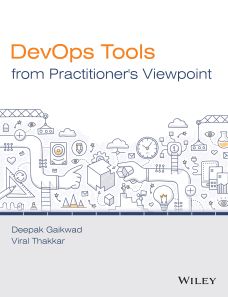DevOps Tools from Practitioner's Viewpoint
ISBN: 9788126579952
176 pages
eBook also available for institutional users
For more information write to us at: acadmktg@wiley.com

Description
This book includes proven step-by-step methodology to adopt DevOps in any project. It provides precise knowledge of tools to architect effective pipelines by selecting tools suitable for specific scenarios. Readers can do this by using features, comparative study, pros and cons, reference architectures and much more about most of the popular tools in open-source and proprietary market. Basic and advance Agile and DevOps concepts in practical context have been discussed to lay strong knowledge foundation for the readers. As DevOps is a continuous process, the establishment of governance around DevOps has been discussed to ensure that projects continue to evolve as they progress in this journey.
Preface
Acknowledgements
List of Figures and Tables
Chapter 1 The World without DevOps, Really?
1.1 Overview
1.2 Problem Case Definition
1.3 Benefits of Fixing Application Development Challenges
1.4 DevOps Adoption Approach through Assessment
1.5 Solution Dimensions
1.6 Structure of the Book
Chapter 2 Agile Methodology and DevOps
2.1 Before Agile – Waterfall
2.2 Agile Development
2.3 What is DevOps?
2.4 DevOps Importance and Benefits
2.5 DevOps Principles and Practices
2.6 7 C’s of DevOps Lifecycle for Business Agility
2.7 DevOps and Continuous Testing
2.8 How to Choose Right DevOps Tools?
2.9 Challenges with DevOps Implementation
2.10 Must Do Things for DevOps
Chapter 3 Map My App to DevOps Journey
3.1 Assessment
3.2 Definition
3.3 Implementation
3.4 Measure and Feedback
Chapter 4 Tool Suits
4.1 Atlassian Tools
4.2 Phabricator
Chapter 5 Orchestration
5.1 Jenkins
5.2 Microsoft TFS
5.3 TeamCity
5.4 Ansible
5.5 Bamboo
Chapter 6 Application Lifecycle Management
6.1 JIRA
Chapter 7 Source Code Management and Quality
7.1 Bitbucket
7.2 Crucible
Chapter 8 Deployment and Infrastructure Management
8.1 Liquibase
8.2 Chef
8.3 Puppet
Chapter 9 DevOps with Cloud
9.1 DevOps and Cloud Adoption
9.2 DevOps in IBM Cloud – Bluemix
9.3 DevOps with VSTS and Azure
9.5 AWS
9.6 OpenShift
Chapter 10 Application Security
10.1 Security with HP Fortify
Chapter 11 DevOps Governance and Controls
11.1 What is DevOps Governance and Controls?
11.2 How to Implement DevOps Governance?
11.3 What are DevOps Governance Benefits?
11.4 Implementing DevOps Controls
Chapter 12 Adopting DevOps
12.1 What is a DevOps Playbook?
12.2 Developing a Playbook
12.3 Implementing DevOps Playbook
Chapter 13 DevOps Best Practices
13.1 Project Structure
13.2 Custom Frameworks
13.3 Separating Unit Test Code from Main Code
13.4 Choosing Correct Branching Strategy
13.5 Check-in and Check-out Practices
13.6 Checkstyle Integration with IDEs
13.7 Standardize Code Review Checks
13.8 Externalize Unit Test Data
13.9 Shift Left
13.10 Externalize Environment-Specific Properties
13.11 Libraries Management
13.12 Right Mindset of Testing Team
13.13 Ensure Collaboration amongst Stakeholders
13.14 Give Weightage to Tool Selection
13.15 Avoid Over-Automation
Chapter 14 DevOps Emerging Trends
14.1 Strategy Trends
14.2 Technology Trends
Appendix: A
Appendix: B

